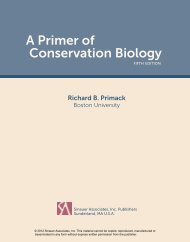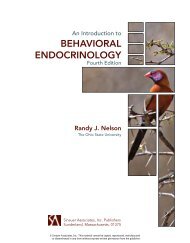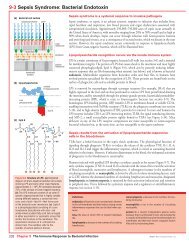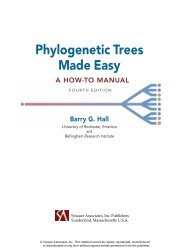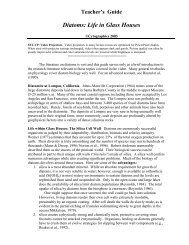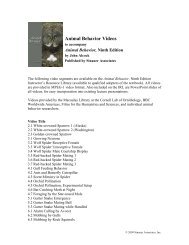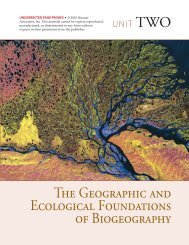Ecology, Second Edition - Sinauer Associates
Ecology, Second Edition - Sinauer Associates
Ecology, Second Edition - Sinauer Associates
You also want an ePaper? Increase the reach of your titles
YUMPU automatically turns print PDFs into web optimized ePapers that Google loves.
ECOLOGY<br />
<strong>Second</strong> <strong>Edition</strong><br />
MICHAEL L. CAIN • Bowdoin College<br />
WILLIAM D. BOWMAN • University of Colorado<br />
SALLY D. HACKER • Oregon State University<br />
<strong>Sinauer</strong> <strong>Associates</strong>, Inc. • Sunderland, Massachusetts<br />
©2012 <strong>Sinauer</strong> <strong>Associates</strong>, Inc. This material cannot be copied, reproduced, manufactured<br />
or disseminated in any form without express written permission from the publisher.
Brief Contents<br />
1 The Web of Life 2<br />
UNIT 1 Organisms and Their Environment<br />
2 The Physical Environment 22<br />
3 The Biosphere 49<br />
4 Coping with Environmental Variation: Temperature and Water 81<br />
5 Coping with Environmental Variation: Energy 106<br />
6 Evolution and <strong>Ecology</strong> 132<br />
UNIT 2 Populations<br />
7 Life History 156<br />
8 Population Distribution and Abundance 177<br />
9 Population Growth and Regulation 199<br />
10 Population Dynamics 221<br />
UNIT 3 Interactions among Organisms<br />
11 Competition 242<br />
12 Predation and Herbivory 262<br />
13 Parasitism 283<br />
14 Mutualism and Commensalism 305<br />
UNIT 4 Communities<br />
15 The Nature of Communities 324<br />
16 Change in Communities 343<br />
17 Biogeography 364<br />
18 Species Diversity in Communities 388<br />
UNIT 5 Ecosystems<br />
19 Production 410<br />
20 Energy Flow and Food Webs 430<br />
21 Nutrient Supply and Cycling 452<br />
UNIT 6 Applied and Large-Scale <strong>Ecology</strong><br />
22 Conservation Biology 476<br />
23 Landscape <strong>Ecology</strong> and Ecosystem Management 501<br />
24 Global <strong>Ecology</strong> 525<br />
©2012 <strong>Sinauer</strong> <strong>Associates</strong>, Inc. This material cannot be copied, reproduced, manufactured<br />
or disseminated in any form without express written permission from the publisher.
Contents<br />
CHAPTER 1 The Web of Life 2<br />
Deformity and Decline in Amphibian Populations:<br />
A Case Study 2<br />
Introduction 3<br />
CONCEPT 1.1 Events in the natural world are<br />
interconnected. 3<br />
Connections in Nature 3<br />
CONCEPT 1.2 <strong>Ecology</strong> is the scientific study of interactions<br />
between organisms and their environment. 8<br />
<strong>Ecology</strong> 8<br />
CONCEPT 1.3 Ecologists evaluate competing hypotheses<br />
about natural systems with observations, experiments,<br />
and models. 13<br />
Answering Ecological Questions 13<br />
ECOLOGICAL TOOLKIT 1.1 Designing Ecological<br />
Experiments 16<br />
A CASE STUDY REVISITED Deformity and Decline in Amphibian<br />
Populations 17<br />
CONNECTIONS IN NATURE Mission Impossible? 18<br />
UNIT 1<br />
Organisms and Their Environment<br />
CHAPTER 2 The Physical Environment 22<br />
Climatic Variation and Salmon Abundance:<br />
A Case Study 22<br />
Introduction 23<br />
CONCEPT 2.1 Climate is the most fundamental component<br />
of the physical environment. 23<br />
Climate 23<br />
CONCEPT 2.2 Winds and ocean currents result from<br />
differences in solar radiation across Earthí s surface. 26<br />
Atmospheric and Oceanic Circulation 26<br />
CONCEPT 2.3 Large scale atmospheric and oceanic<br />
circulation patterns establish global patterns of<br />
temperature and precipitation. 31<br />
Global Climatic Patterns 31<br />
CONCEPT 2.4 Regional climates reflect the influence of the<br />
distribution of oceans and continents, mountains, and<br />
vegetation. 34<br />
Regional Climatic Influences 34<br />
CONCEPT 2.5 Seasonal and long term climatic variation are<br />
associated with changes in Earthí s position relative to<br />
the sun. 37<br />
Climatic Variation over Time 37<br />
CONCEPT 2.6 Salinity, acidity, and oxygen concentrations<br />
are major determinants of the chemical<br />
environment. 42<br />
The Chemical Environment 42<br />
A CASE STUDY REVISITED Climatic Variation and Salmon<br />
Abundance 45<br />
CONNECTIONS IN NATURE Climatic Variation and<br />
<strong>Ecology</strong> 47<br />
©2012 <strong>Sinauer</strong> <strong>Associates</strong>, Inc. This material cannot be copied, reproduced, manufactured<br />
or disseminated in any form without express written permission from the publisher.
xvi<br />
Contents<br />
CHAPTER 3 The Biosphere 49<br />
The American Serengeti—Twelve Centuries of Change<br />
in the Great Plains: A Case Study 49<br />
Introduction 50<br />
CONCEPT 3.1 Terrestrial biomes are characterized by the<br />
growth forms of the dominant vegetation. 50<br />
Terrestrial Biomes 50<br />
CONCEPT 3.2 Biological zones in freshwater ecosystems<br />
are associated with the velocity, depth, temperature,<br />
clarity, and chemistry of the water. 68<br />
Freshwater Biological Zones 68<br />
CONCEPT 3.3 Marine biological zones are determined by<br />
ocean depth, light availability, and the stability of the<br />
bottom substrate. 70<br />
Marine Biological Zones 70<br />
A CASE STUDY REVISITED The American Serengeti—Twelve<br />
Centuries of Change in the Great Plains 76<br />
CONNECTIONS IN NATURE Long-Term Ecological<br />
Research 77<br />
CHAPTER 4 Coping with Environmental<br />
Variation: Temperature and<br />
Water 81<br />
Frozen Frogs: A Case Study 81<br />
Introduction 82<br />
CONCEPT 4.1 Each species has a range of environmental<br />
tolerances that determines its potential geographic<br />
distribution. 82<br />
Response to Environmental Variation 82<br />
CONCEPT 4.2 The temperature of an organism is<br />
determined by exchanges of energy with the external<br />
environment. 85<br />
Variation in Temperature 85<br />
CONCEPT 4.3 The water balance of an organism is<br />
determined by exchanges of water and solutes with the<br />
external environment. 94<br />
Variation in Water Availability 94<br />
A CASE STUDY REVISITED Frozen Frogs 101<br />
CONNECTIONS IN NATURE Desiccation Tolerance, Body Size,<br />
and Rarity 102<br />
CHAPTER 5 Coping with Environmental<br />
Variation: Energy 106<br />
Toolmaking Crows: A Case Study 106<br />
Introduction 107<br />
CONCEPT 5.1 Organisms obtain energy from sunlight,<br />
from inorganic chemical compounds, or through the<br />
consumption of organic compounds. 107<br />
Sources of Energy 107<br />
CONCEPT 5.2 Radiant and chemical energy captured by<br />
autotrophs is converted into stored energy in carbon–<br />
carbon bonds. 109<br />
Autotrophy 109<br />
CONCEPT 5.3 Environmental constraints have resulted in the<br />
evolution of biochemical pathways that improve the<br />
efficiency of photosynthesis. 113<br />
Photosynthetic Pathways 113<br />
CONCEPT 5.4 Heterotrophs have adaptations for acquiring<br />
and assimilating energy efficiently from a variety of<br />
organic sources. 119<br />
Heterotrophy 119<br />
ECOLOGICAL TOOLKIT 5.1 Stable Isotopes 120<br />
A CASE STUDY REVISITED Toolmaking Crows 128<br />
CONNECTIONS IN NATURE Tool Use: Adaptation or Learned<br />
Behavior? 129<br />
CHAPTER 6 Evolution and <strong>Ecology</strong> 132<br />
Trophy Hunting and Inadvertent Evolution: A Case<br />
Study 132<br />
Introduction 133<br />
CONCEPT 6.1 Evolution can be viewed as genetic<br />
change over time or as a process of descent with<br />
modification. 133<br />
What Is Evolution? 133<br />
CONCEPT 6.2 Natural selection, genetic drift, and gene flow<br />
can cause allele frequencies in a population to change<br />
over time. 136<br />
Mechanisms of Evolution 136<br />
CONCEPT 6.3 Natural selection is the only evolutionary<br />
mechanism that consistently causes adaptive<br />
evolution. 140<br />
Adaptive Evolution 140<br />
CONCEPT 6.4 Long-term patterns of evolution are shaped<br />
by large-scale processes such as speciation, mass<br />
extinction, and adaptive radiation. 144<br />
The Evolutionary History of Life 144<br />
CONCEPT 6.5 Ecological interactions and evolution exert a<br />
profound influence on one another. 148<br />
Joint Effects of <strong>Ecology</strong> and Evolution 148<br />
A CASE STUDY REVISITED Trophy Hunting and Inadvertent<br />
Evolution 151<br />
CONNECTIONS IN NATURE The Human Impact on<br />
Evolution 151<br />
©2012 <strong>Sinauer</strong> <strong>Associates</strong>, Inc. This material cannot be copied, reproduced, manufactured<br />
or disseminated in any form without express written permission from the publisher.
Contents<br />
xvii<br />
UNIT 2<br />
Populations<br />
CHAPTER 7 Life History 156<br />
Nemo Grows Up: A Case Study 156<br />
Introduction 157<br />
CONCEPT 7.1 Life history patterns vary within and among<br />
species. 157<br />
Life History Diversity 157<br />
CONCEPT 7.2 Reproductive patterns can be classified along<br />
several continua. 164<br />
Life History Continua 164<br />
CONCEPT 7.3 There are trade-offs between life history<br />
traits. 167<br />
Trade-Offs 167<br />
CONCEPT 7.4 Organisms face different selection pressures<br />
at different life cycle stages. 170<br />
Life Cycle Evolution 170<br />
A CASE STUDY REVISITED Nemo Grows Up 173<br />
CONNECTIONS IN NATURE Territoriality, Competition, and<br />
Life History 174<br />
CHAPTER 8 Population Distribution and<br />
Abundance 177<br />
From Kelp Forest to Urchin Barren: A Case Study 177<br />
Introduction 178<br />
CONCEPT 8.1 Populations are dynamic entities that vary in<br />
size over time and space. 178<br />
Populations 178<br />
CONCEPT 8.2 The distributions and abundances of<br />
organisms are limited by habitat suitability, historical<br />
factors, and dispersal. 182<br />
Distribution and Abundance 182<br />
CONCEPT 8.3 Many species have a patchy distribution of<br />
populations across their geographic range. 186<br />
Geographic Range 186<br />
CONCEPT 8.4 The dispersion of individuals within a<br />
population depends on the location of essential<br />
resources, competition, dispersal, and behavioral<br />
interactions. 188<br />
Dispersion within Populations 188<br />
CONCEPT 8.5 Population abundances and distributions<br />
can be estimated with area-based counts, distance<br />
methods, mark–recapture studies, and niche<br />
modeling. 190<br />
Estimating Abundances and Distributions 190<br />
ECOLOGICAL TOOLKIT 8.1 Estimating Abundance 191<br />
A CASE STUDY REVISITED From Kelp Forest to Urchin<br />
Barren 194<br />
CONNECTIONS IN NATURE From Urchins to Ecosystems 196<br />
CHAPTER 9 Population Growth and<br />
Regulation 199<br />
Human Population Growth: A Case Study 199<br />
Introduction 200<br />
CONCEPT 9.1 Life tables show how survival and<br />
reproductive rates vary with age, size, or life cycle<br />
stage. 201<br />
Life Tables 201<br />
CONCEPT 9.2 Life table data can be used to project<br />
the future age structure, size, and growth rate of a<br />
population. 204<br />
Age Structure 204<br />
CONCEPT 9.3 Populations can grow exponentially when<br />
conditions are favorable, but exponential growth<br />
cannot continue indefinitely. 207<br />
Exponential Growth 207<br />
ECOLOGICAL TOOLKIT 9.1 Estimating Population Growth<br />
Rates in a Threatened Species 208<br />
CONCEPT 9.4 Population size can be determined by<br />
density-dependent and density-independent<br />
factors. 211<br />
Effects of Density 211<br />
CONCEPT 9.5 The logistic equation incorporates limits to<br />
growth and shows how a population may stabilize at a<br />
maximum size, the carrying capacity. 214<br />
Logistic Growth 214<br />
A CASE STUDY REVISITED Human Population Growth 216<br />
CONNECTIONS IN NATURE Your Ecological Footprint 217<br />
©2012 <strong>Sinauer</strong> <strong>Associates</strong>, Inc. This material cannot be copied, reproduced, manufactured<br />
or disseminated in any form without express written permission from the publisher.
xviii<br />
Contents<br />
CHAPTER 10 Population Dynamics 221<br />
A Sea in Trouble: A Case Study 221<br />
Introduction 222<br />
CONCEPT 10.1 Populations exhibit a wide range of growth<br />
patterns, including exponential growth, logistic growth,<br />
fluctuations, and regular cycles. 223<br />
Patterns of Population Growth 223<br />
CONCEPT 10.2 Delayed density dependence can cause<br />
populations to fluctuate in size. 226<br />
Delayed Density Dependence 226<br />
CONCEPT 10.3 The risk of extinction increases greatly in<br />
small populations. 229<br />
Population Extinction 229<br />
CONCEPT 10.4 Many species have a metapopulation<br />
structure in which sets of spatially isolated populations<br />
are linked by dispersal. 234<br />
Metapopulations 234<br />
A CASE STUDY REVISITED A Sea in Trouble 237<br />
CONNECTIONS IN NATURE From Bottom to Top, and Back<br />
Again 237<br />
UNIT 3<br />
Interactions among Organisms<br />
CHAPTER 11 Competition 242<br />
Competition in Plants That Eat Animals: A Case<br />
Study 242<br />
Introduction 243<br />
CONCEPT 11.1 Competition occurs between individuals of<br />
two species that share the use of a resource that limits<br />
their growth, survival, or reproduction. 243<br />
Competition for Resources 243<br />
CONCEPT 11.2 Competition, whether direct or indirect, can<br />
limit the distributions and abundances of competing<br />
species. 246<br />
General Features of Competition 246<br />
CONCEPT 11.3 Competing species are more likely to coexist<br />
when they use resources in different ways. 249<br />
Competitive Exclusion 249<br />
ECOLOGICAL TOOLKIT 11.1 Isocline Analyses 252<br />
CONCEPT 11.4 The outcome of competition can be altered<br />
by environmental conditions, species interactions,<br />
disturbance, and evolution. 254<br />
Altering the Outcome of Competition 254<br />
A CASE STUDY REVISITED Competition in Plants That Eat<br />
Animals 257<br />
CONNECTIONS IN NATURE The Paradox of Diversity 258<br />
CHAPTER 12 Predation and<br />
Herbivory 262<br />
Snowshoe Hare Cycles: A Case Study 262<br />
Introduction 263<br />
CONCEPT 12.1 Most predators have broad diets, whereas<br />
a majority of herbivores have relatively narrow<br />
diets. 264<br />
Predators and Herbivores 264<br />
CONCEPT 12.2 Organisms have evolved a wide range of<br />
adaptations that help them obtain food and avoid<br />
being eaten. 266<br />
Adaptations to Exploitative Interactions 266<br />
CONCEPT 12.3 Predation and herbivory can affect<br />
ecological communities greatly, in some cases causing a<br />
shift from one community type to another. 271<br />
Effects of Exploitation on Communities 271<br />
CONCEPT 12.4 Population cycles can be caused by<br />
exploitative interactions. 275<br />
Exploitation and Population Cycles 275<br />
A CASE STUDY REVISITED Snowshoe Hare Cycles 278<br />
CONNECTIONS IN NATURE From Fear to Hormones to<br />
Population Dynamics 280<br />
CHAPTER 13 Parasitism 283<br />
Enslaver Parasites: A Case Study 283<br />
Introduction 284<br />
©2012 <strong>Sinauer</strong> <strong>Associates</strong>, Inc. This material cannot be copied, reproduced, manufactured<br />
or disseminated in any form without express written permission from the publisher.
Contents<br />
xix<br />
CONCEPT 13.1 Parasites typically feed on only one or a few<br />
host individuals. 285<br />
Parasite Natural History 285<br />
CONCEPT 13.2 Hosts have adaptations for defending<br />
themselves against parasites, and parasites have<br />
adaptations for overcoming host defenses. 287<br />
Defenses and Counterdefenses 287<br />
CONCEPT 13.3 Host and parasite populations can evolve<br />
together, each in response to selection pressure<br />
imposed by the other. 290<br />
Parasite–Host Coevolution 290<br />
CONCEPT 13.4 Parasites can reduce the sizes of host populations<br />
and alter the outcomes of species interactions,<br />
thereby causing communities to change. 293<br />
Ecological Effects of Parasites 293<br />
CONCEPT 13.5 Simple models of host–pathogen dynamics<br />
suggest ways to control the establishment and spread<br />
of diseases. 297<br />
Dynamics and Spread of Diseases 297<br />
A CASE STUDY REVISITED Enslaver Parasites 301<br />
CONNECTIONS IN NATURE From Chemicals to Evolution and<br />
Ecosystems 302<br />
CHAPTER 14 Mutualism and<br />
Commensalism 305<br />
The First Farmers: A Case Study 305<br />
Introduction 306<br />
CONCEPT 14.1 In positive interactions, neither species is<br />
harmed and the benefits of the interaction are greater<br />
than the costs for at least one species. 306<br />
Positive Interactions 306<br />
CONCEPT 14.2 Each partner in a mutualistic interaction acts<br />
in ways that serve its own ecological and evolutionary<br />
interests. 313<br />
Characteristics of Mutualism 313<br />
CONCEPT 14.3 Positive interactions affect the abundances<br />
and distributions of populations as well as the<br />
composition of ecological communities. 316<br />
Ecological Consequences of Positive<br />
Interactions 316<br />
A CASE STUDY REVISITED The First Farmers 319<br />
CONNECTIONS IN NATURE From Mandibles to Nutrient<br />
Cycling 320<br />
UNIT 4<br />
Communities<br />
CHAPTER 15 The Nature of<br />
Communities 324<br />
“Killer Algae!”: A Case Study 324<br />
Introduction 325<br />
CONCEPT 15.1 Communities are groups of interacting species<br />
that occur together at the same place and time. 325<br />
What Are Communities? 325<br />
CONCEPT 15.2 Species diversity and species composition<br />
are important descriptors of community<br />
structure. 328<br />
Community Structure 328<br />
CONCEPT 15.3 Communities can be characterized by<br />
complex networks of direct and indirect interactions<br />
that vary in strength and direction. 333<br />
Interactions of Multiple Species 333<br />
ECOLOGICAL TOOLKIT 15.1 Measurements of Interaction<br />
Strength 337<br />
A CASE STUDY REVISITED “Killer Algae!” 340<br />
CONNECTIONS IN NATURE Stopping Invasions Requires<br />
Commitment 340<br />
CHAPTER 16 Change in<br />
Communities 343<br />
A Natural Experiment of Mountainous Proportions:<br />
A Case Study 343<br />
Introduction 344<br />
CONCEPT 16.1 Agents of change act on communities across<br />
all temporal and spatial scales. 345<br />
Agents of Change 345<br />
CONCEPT 16.2 Succession is the process of change in<br />
species composition over time as a result of abiotic and<br />
biotic agents of change. 347<br />
Basics of Succession 347<br />
©2012 <strong>Sinauer</strong> <strong>Associates</strong>, Inc. This material cannot be copied, reproduced, manufactured<br />
or disseminated in any form without express written permission from the publisher.
xx<br />
Contents<br />
CONCEPT 16.3 Experimental work on succession<br />
shows its mechanisms to be diverse and contextdependent.<br />
351<br />
Mechanisms of Succession 351<br />
CONCEPT 16.4 Communities can follow different<br />
successional paths and display alternative states. 357<br />
Alternative Stable States 357<br />
A CASE STUDY REVISITED A Natural Experiment of<br />
Mountainous Proportions 359<br />
CONNECTIONS IN NATURE Primary Succession and<br />
Mutualism 361<br />
CHAPTER 17 Biogeography 364<br />
The Largest Ecological Experiment on Earth: A Case<br />
Study 364<br />
Introduction 365<br />
CONCEPT 17.1 Patterns of species diversity and distribution<br />
vary at global, regional, and local spatial scales. 365<br />
Biogeography and Spatial Scale 365<br />
CONCEPT 17.2 Global patterns of species diversity and<br />
composition are influenced by geographic area<br />
and isolation, evolutionary history, and global<br />
climate. 371<br />
Global Biogeography 371<br />
CONCEPT 17.3 Regional differences in species diversity<br />
are influenced by area and distance, which determine<br />
the balance between immigration and extinction<br />
rates. 378<br />
Regional Biogeography 378<br />
ECOLOGICAL TOOLKIT 17.1 Species–Area Curves 380<br />
A CASE STUDY REVISITED The Largest Ecological Experiment<br />
on Earth 384<br />
CONNECTIONS IN NATURE Tropical Rainforest Diversity<br />
Benefits Humans 385<br />
CHAPTER 18 Species Diversity in<br />
Communities 388<br />
Powered by Prairies? Biodiversity and Biofuels: A Case<br />
Study 388<br />
Introduction 389<br />
CONCEPT 18.1 Species diversity differs among communities<br />
due to variation in regional species pools, abiotic<br />
conditions, and species interactions. 389<br />
Community Membership 389<br />
CONCEPT 18.2 Resource partitioning among the species<br />
in a community reduces competition and increases<br />
species diversity. 393<br />
Resource Partitioning 393<br />
CONCEPT 18.3 Processes such as disturbance, stress,<br />
predation, and positive interactions can mediate<br />
resource availability, thus promoting species<br />
coexistence and species diversity. 396<br />
Processes That Promote Coexistence 396<br />
CONCEPT 18.4 Many experiments show that species<br />
diversity is positively related to community<br />
function. 402<br />
The Consequences of Diversity 402<br />
A CASE STUDY REVISITED Powered by Prairies? Biodiversity<br />
and Biofuels 405<br />
CONNECTIONS IN NATURE Barriers to Biofuels: The Plant Cell<br />
Wall Conundrum 406<br />
UNIT 5<br />
Ecosystems<br />
CHAPTER 19 Production 410<br />
Life in the Deep Blue Sea, How Can It Be?:<br />
A Case Study 410<br />
Introduction 411<br />
CONCEPT 19.1 Energy in ecosystems originates with primary<br />
production by autotrophs. 412<br />
Primary Production 412<br />
ECOLOGICAL TOOLKIT 19.1 Remote Sensing 416<br />
CONCEPT 19.2 Net primary production is constrained by<br />
both physical and biotic environmental factors. 418<br />
Environmental Controls on NPP 418<br />
CONCEPT 19.3 Global patterns of net primary production<br />
reflect climatic constraints and biome types. 423<br />
Global Patterns of NPP 423<br />
©2012 <strong>Sinauer</strong> <strong>Associates</strong>, Inc. This material cannot be copied, reproduced, manufactured<br />
or disseminated in any form without express written permission from the publisher.
Contents<br />
xxi<br />
CONCEPT 19.4 <strong>Second</strong>ary production is generated<br />
through the consumption of organic matter by<br />
heterotrophs. 424<br />
<strong>Second</strong>ary Production 424<br />
A CASE STUDY REVISITED Life in the Deep Blue Sea,<br />
How Can It Be? 425<br />
CONNECTIONS IN NATURE Energy-Driven Succession and<br />
Evolution in Hydrothermal Vent Communities 426<br />
CHAPTER 20 Energy Flow and Food<br />
Webs 430<br />
Toxins in Remote Places: A Case Study 430<br />
Introduction 431<br />
CONCEPT 20.1 Trophic levels describe the feeding<br />
positions of groups of organisms in ecosystems. 431<br />
Feeding Relationships 431<br />
CONCEPT 20.2 The amount of energy transferred from one<br />
trophic level to the next depends on food quality and<br />
consumer abundance and physiology. 433<br />
Energy Flow among Trophic Levels 433<br />
CONCEPT 20.3 Changes in the abundances of organisms at<br />
one trophic level can influence energy flow at multiple<br />
trophic levels. 438<br />
Trophic Cascades 438<br />
CONCEPT 20.4 Food webs are conceptual models<br />
of the trophic interactions of organisms in an<br />
ecosystem. 442<br />
Food Webs 442<br />
A CASE STUDY REVISITED Toxins in Remote Places 448<br />
CONNECTIONS IN NATURE Biological Transport of<br />
Pollutants 449<br />
CHAPTER 21 Nutrient Supply and<br />
Cycling 452<br />
A Fragile Crust: A Case Study 452<br />
Introduction 453<br />
CONCEPT 21.1 Nutrients enter ecosystems through the<br />
chemical breakdown of minerals in rocks or through<br />
fixation of atmospheric gases. 454<br />
Nutrient Requirements and Sources 454<br />
CONCEPT 21.2 Chemical and biological transformations<br />
in ecosystems alter the chemical form and supply of<br />
nutrients. 458<br />
Nutrient Transformations 458<br />
CONCEPT 21.3 Nutrients cycle repeatedly through the<br />
components of ecosystems. 461<br />
Nutrient Cycles and Losses 461<br />
ECOLOGICAL TOOLKIT 21.1 Instrumenting<br />
Catchments 465<br />
CONCEPT 21.4 Freshwater and marine ecosystems receive<br />
nutrient inputs from terrestrial ecosystems. 467<br />
Nutrients in Aquatic Ecosystems 467<br />
A CASE STUDY REVISITED A Fragile Crust 470<br />
CONNECTIONS IN NATURE Nutrients, Disturbance, and<br />
Invasive Species 471<br />
UNIT 6<br />
Applied and Large-Scale <strong>Ecology</strong><br />
CHAPTER 22 Conservation Biology 476<br />
Can Birds and Bombs Coexist?: A Case Study 476<br />
Introduction 477<br />
CONCEPT 22.1 Conservation biology is an integrative<br />
discipline that applies the principles of ecology to the<br />
conservation of biodiversity. 477<br />
Conservation Biology 477<br />
CONCEPT 22.2 Biodiversity is declining globally. 480<br />
Declining Biodiversity 480<br />
CONCEPT 22.3 Primary threats to biodiversity include<br />
habitat loss, invasive species, overexploitation,<br />
pollution, disease, and climate change. 484<br />
Threats to Biodiversity 484<br />
CONCEPT 22.4 Conservation biologists use many tools<br />
and work at multiple scales to manage declining<br />
populations. 490<br />
Approaches to Conservation 490<br />
ECOLOGICAL TOOLKIT 22.1 Forensics in Conservation<br />
Biology 492<br />
©2012 <strong>Sinauer</strong> <strong>Associates</strong>, Inc. This material cannot be copied, reproduced, manufactured<br />
or disseminated in any form without express written permission from the publisher.
xxii<br />
Contents<br />
CONCEPT 22.5 Prioritizing species helps maximize the<br />
biodiversity that can be protected with limited<br />
resources. 495<br />
Ranking Species for Protection 495<br />
A CASE STUDY REVISITED Can Birds and Bombs Coexist? 497<br />
CONNECTIONS IN NATURE Some Burning Questions 498<br />
CHAPTER 23 Landscape <strong>Ecology</strong><br />
and Ecosystem<br />
Management 501<br />
Wolves in the Yellowstone Landscape:<br />
A Case Study 501<br />
Introduction 502<br />
ECOLOGICAL TOOLKIT 23.1 Geographic Information<br />
Systems (GIS) 503<br />
CONCEPT 23.1 Landscape ecology examines spatial<br />
patterns and their relationship to ecological processes<br />
and changes. 504<br />
Landscape <strong>Ecology</strong> 504<br />
CONCEPT 23.2 Habitat loss and fragmentation decreases<br />
habitat area, isolates populations, and alters conditions<br />
at habitat edges. 508<br />
Habitat Loss and Fragmentation 508<br />
CONCEPT 23.3 Biodiversity can best be sustained by large<br />
reserves connected across the landscape and buffered<br />
from areas of intense human use. 514<br />
Designing Nature Reserves 514<br />
CONCEPT 23.4 Ecosystem management is a collaborative<br />
process with the maintenance of long-term ecological<br />
integrity as its core value. 518<br />
Ecosystem Management 518<br />
A CASE STUDY REVISITED Wolves in the Yellowstone<br />
Landscape 520<br />
CONNECTIONS IN NATURE Future Changes in the Yellowstone<br />
Landscape 521<br />
CHAPTER 24 Global <strong>Ecology</strong> 525<br />
Dust Storms of Epic Proportions: A Case Study 525<br />
Introduction 526<br />
CONCEPT 24.1 Elements move among geologic,<br />
atmospheric, oceanic, and biological pools at a global<br />
scale. 526<br />
Global Biogeochemical Cycles 526<br />
CONCEPT 24.2 Earth is warming due to anthropogenic<br />
emissions of greenhouse gases. 532<br />
Global Climate Change 532<br />
CONCEPT 24.3 Anthropogenic emissions of sulfur and<br />
nitrogen cause acid deposition, alter soil chemistry, and<br />
affect the health of ecosystems. 539<br />
Acid and Nitrogen Deposition 539<br />
CONCEPT 24.4 Losses of ozone in the stratosphere and<br />
increases in ozone in the troposphere each pose risks<br />
to organisms. 543<br />
Atmospheric Ozone 543<br />
A CASE STUDY REVISITED Dust Storms of Epic<br />
Proportions 546<br />
CONNECTIONS IN NATURE Dust as a Vector of Ecological<br />
Impacts 548<br />
Appendix 551<br />
Answers to Figure Legend and Review<br />
Questions 553<br />
Glossary 575<br />
Illustration Credits 587<br />
Literature Cited 591<br />
Index 613<br />
©2012 <strong>Sinauer</strong> <strong>Associates</strong>, Inc. This material cannot be copied, reproduced, manufactured<br />
or disseminated in any form without express written permission from the publisher.




